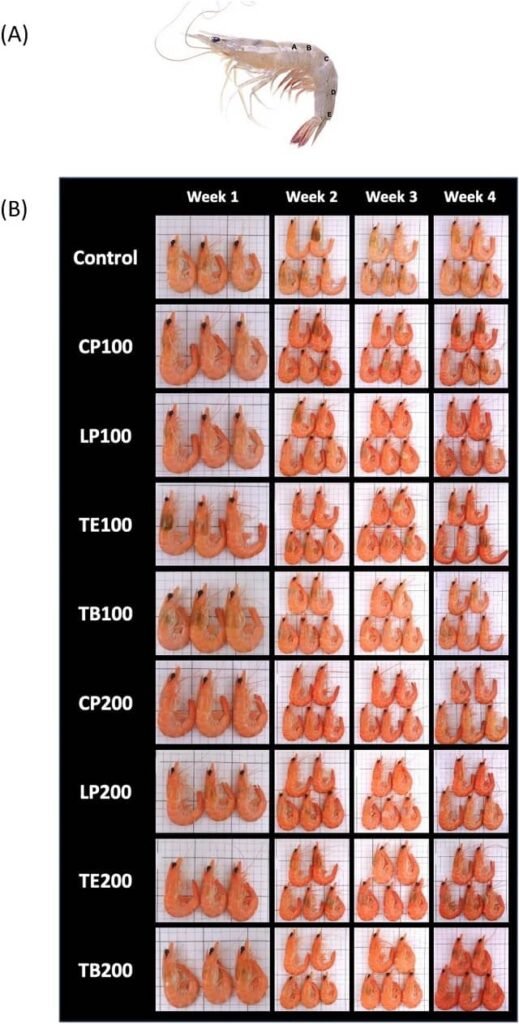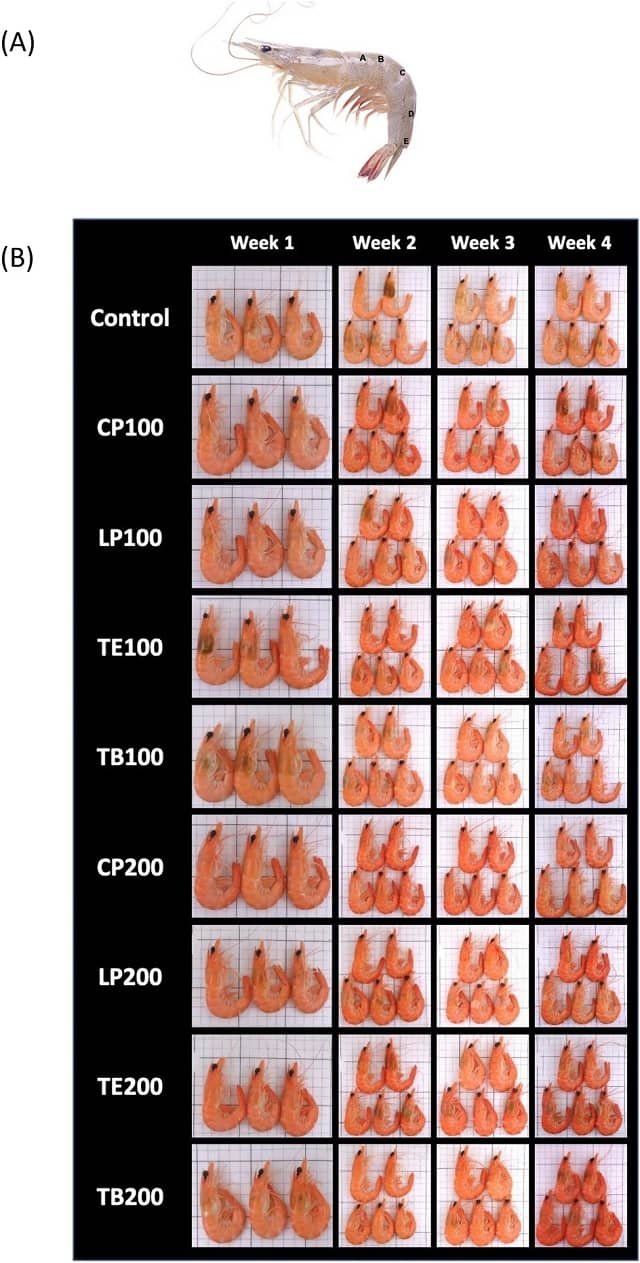
Astaxanthin (AST), a super antioxidant with medicinal and coloring properties, makes it a beneficial feed additive for shrimp.
White vannamei shrimp can store high levels of the antioxidant astaxanthin, which manifest as a red coloration when the shrimp is cooked.
Consumer purchasing power is affected by color, so the price of red shrimp will be higher.
A team of researchers from National Chung Hsing University, China Medical University Hospital, and National Taiwan Ocean University compared the effects of astaxanthin produced by Kluveromyces marxianus and chemically derived on genes linked to immunity and the red coloration of the white shrimp (Penaeus vannamei).
The study also looked at the potential commercial uses of 3S, 3’S-ASTX produced by Kluveromyces marxianus; to investigate whether shrimp fed a diet containing astaxanthin might exhibit non-specific immune responses.
In addition, the researchers analyzed the effects of astaxanthin on resistance to infection with Vibrio parahaemolyticus in P. vannamei.
The power of astaxanthin
The demand for astaxanthin for food, feed, cosmetic and pharmaceutical applications has been increasing due to its superior antioxidant and coloring properties.
Researchers suggest astaxanthin is an essential growth factor in the early stages of shrimp development.
Stay Always Informed
Join our communities to instantly receive the most important news, reports, and analysis from the aquaculture industry.
On the other hand, the innate immune system of shrimp can be modulated by astaxanthin treatment via increased immune responses, including hematocyte count, lysozyme, phagocytic activity, phenol oxidase, etc.
Currently, the alga Haematococcus pluvialis, the yeast Xanthophyllomyces dendrorhous, and the bacterium Paracoccus carotinifaciens are being used for the commercial production of two natural forms of stereoisomers: 3S and 3R.
Astaxanthin can promote shrimp health to increase production, and also significantly increase the red color of the shrimp body, thereby increasing the price.
However, the natural production of astaxanthin is expensive, mainly due to its low productivity and limited sources.
Chemically derived astaxanthin is commonly used as a feed additive in aquaculture, but synthetic forms of the 3R, 3’S forms (3S, 3’R) can be toxic to humans and the production process can cause environmental contamination.
Astaxanthin and shrimp coloration
“Our results reveal that reddish and yellowish coloration is significantly increased at week two in all shrimp that received the astaxanthin-supplemented feeds, compared to those that received the control feed,” the researchers report.
However, they note, the results indicate a dose-independent difference in coloration between shrimp that received the astaxanthin-supplemented feeds.
“We observed that shrimp that received TE200, which was supplemented with 3S, 3’S-AST derived from K. marxianus, had the highest red coloration values at weeks 1 and 2, compared to those that received the other astaxanthin-supplemented feeds.”, they report.
Immune responses, including phagocytosis activity, superoxide anion production, phenoloxidase activity, and immune-related genes, were examined on days 0, 1, 2, 4, 7, 14, 21, and 28.
In general, shrimp receiving AST-supplemented feeds exhibited higher immune responses on days 7 and 14 than the control feed.
“Our findings suggest a wide range of physiological benefits of 3S astaxanthin, 3’S-AST derived from K. marxianus; among which are included improvements in survival, pigmentation, stress tolerance, disease resistance, and gene expression related to immunity”, they conclude.
Conclusion
“Incorporation of astaxanthin into diets improved shrimp red coloration, immunological parameters, and resistance against V. parahaemolyticus infection,” the researchers conclude.
Both 3S-astaxanthin, K. marxianus-derived 3’S-AST, and chemically-derived astaxanthin enhanced the red body coloration of vannamei shrimp, especially those that received TE200, TB100, and TB200.
They further highlight that K. marxianus-derived astaxanthin exhibited higher performance than chemical astaxanthin to be a potential feed additive in shrimp aquaculture.
“Administration of 3S astaxanthin, 3’S-AST derived from K. marxianus improved multiple immunological parameters and prevented V. parahaemolyticus infection in shrimp.
Contact
Fan-Hua Nan
Department of Aquaculture,
National Taiwan Ocean University,
No. 2, Pei-Ning Road, Keelung, 20224, Taiwan, ROC
Email: fhnan@mail.ntou.edu.tw
Reference (open access)
Lin, YJ., Chang, JJ., Huang, HT. et al. Improving red-color performance, immune response and resistance to Vibrio parahaemolyticus on white shrimp Penaeus vannamei by an engineered astaxanthin yeast. Sci Rep 13, 2248 (2023). https://doi.org/10.1038/s41598-023-29225-4
Editor at the digital magazine AquaHoy. He holds a degree in Aquaculture Biology from the National University of Santa (UNS) and a Master’s degree in Science and Innovation Management from the Polytechnic University of Valencia, with postgraduate diplomas in Business Innovation and Innovation Management. He possesses extensive experience in the aquaculture and fisheries sector, having led the Fisheries Innovation Unit of the National Program for Innovation in Fisheries and Aquaculture (PNIPA). He has served as a senior consultant in technology watch, an innovation project formulator and advisor, and a lecturer at UNS. He is a member of the Peruvian College of Biologists and was recognized by the World Aquaculture Society (WAS) in 2016 for his contribution to aquaculture.




